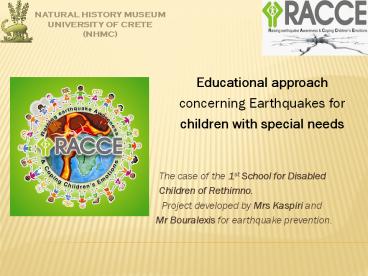Educational approach - PowerPoint PPT Presentation
Title:
Educational approach
Description:
NATURAL HISTORY MUSEUM UNIVERSITY OF CRETE (NHMC) Educational approach concerning Earthquakes for children with special needs The case of the 1st School for Disabled – PowerPoint PPT presentation
Number of Views:25
Avg rating:3.0/5.0
Title: Educational approach
1
NATURAL HISTORY MUSEUM UNIVERSITY OF CRETE
(NHMC)
- Educational approach
- concerning Earthquakes for
- children with special needs
- The case of the 1st School for
Disabled - Children of Rethimno.
- Project developed by Mrs
Kaspiri and - Mr Bouralexis for
earthquake prevention.
2
MAIN PRINCIPAL OF THE EDUCATIONAL APPROACH
- The educational steps focus on
- what should be done rather than on
- what should be avoided!
3
The approach is based on
- Experiential Learning
- Structured Learning
- Visual arts
- Stirs the attention of the students and ensure
their active participation by using - developing
of senses sight, touch, hearing, taste, smell
4
Presentation of Structure teaching plan
- Stimulation of attention
- Contact with natural phenomena (as an
event/fact). - Natural events and disasters.
- First contact with the earthquake - video.
- Discussion-questioning-conclusions
- First experimental phase Action
- We become ... actors, journalists
- Acquisition of experience
- Visit the Natural History Museum of Crete
- Discussion-Questioning-Conclusions
- Second experimental phase Action
- We become ... graphic designers, actors,
journalists - Enhancing acquired knowledge
- Jigsaw-Photos
- Picture-story- School Newspaper
- interdisciplinary approach
- Drills spatial cognition
- Conclusions
5
Stimulation of attention
- Contact with natural phenomena (not the concept
of "natural phenomenon" but the fact) - Natural events and disasters.
- First contact with the earthquake - video.
- Discussion-questioning-conclusions
6
Contact with natural phenomena (fact)
- Rainbow
7
- Thunder
8
Natural events and disasters
- Flood Tsunami
Fire
9
Consolidation activity identification of a
natural phenomenon - consistency, disaster
- Flood Tsunami Fire
10
Introducing the earthquake phenomenon
11
First contact with the earthquake - video.
- Watch the video clip with an earthquake song
from a Greek band called Imiskoubria - Earthquake simulation video from EPPO
- Thales by himself at home!
- Thales trained at the supermarket!
12
Discussion-questioning-conclusions
- Discussion-questioning
- What should we do in case we are at home?
- Conclusions
- Regarding our behavior at school
- During the lesson ? in case of an earthquake ? we
get under the desks
13
2. First experimental phase Action
- We become ... actors, journalists
- We try to put into practice the conclusions of
our discussion. - Earthquake drill
- Before the earthquake
- As normally we are taking our classes
- Earthquake occurs
- During the earthquake
- We get under the desk
- Simultaneously we are taking photos of the entire
action in each class. We create a jigsaw with the
taken photos and the pieces have the same number
as the students. - (we use the "-chrits chrats" to easily
consolidate-education.)
14
Example
- before the earthquake
- Picture Watermark
Jigsaw - during the earthquake
- Picture Watermark
Jigsaw
15
3. Acquisition of experience
- Visit the Natural History
- Museum of Crete
- Use the seismic simulator
- Discussion-questioning
- The earthquake frighten us
- Earthquakes are dangerous
- Conclusions
- When the earthquake stops we get out of the
building using the faster way out.
16
4. Second experimental phase Action
- We become ... graphic designers
- Each teacher discuss with his students for the
escape route of escape in case of earthquake. - Each teacher with the students who can decide to
design the escape route on the floor using
colored duct tape and spray color in order to
create a line of their favorite color.
17
- actors, journalists
- We decide to shoot a new integrated movie with
our own script and us as actors During the
lesson an earthquake occurs and - we get under the desks. After the earthquake
stops - we follow the escape route we have designed
18
5. Enhancing acquired knowledge
- before the earthquake
during the earthquake - Picture Watermark Jigsaw
Picture Watermark
Jigsaw - after the earthquake
- Escape route
in the courtyard!
19
What do we need in case of an earthquake
20
Two-page picture story (upper level)
21
Children with movement disorders
Earthquake...
During the lesson
Waiting. . .
The exit !!
22
Interdisciplinary approach
Within the thematic course of grammar, depending
on the cognition of the children, other
activities can be realised... linear
expression!
writing with glitter - matching image with
word! visualisation of words
duplication
...consolidation of grammar
Earthquake
23
Drills spatial cognition
The concept of space practicing the concepts
under and above using toys and
themselves the doll under the table
the student under
the table the doll above the
table the
student above the table practicing the
concepts in and outside using toys and
themselves the doll in the dollhouse
the student in the
dollhouse the doll outside the dollhouse
the student outside the
dollhouse
24
6. Conclusions
- In the area of Special Needs Education can be
taught and understoodearthquakes in order to
properly deal with thewith the aid - imagination
- experiential learning
- several repetitions
- and of course creating
- the appropriate atmosphere!!!
25
- Thank you!































